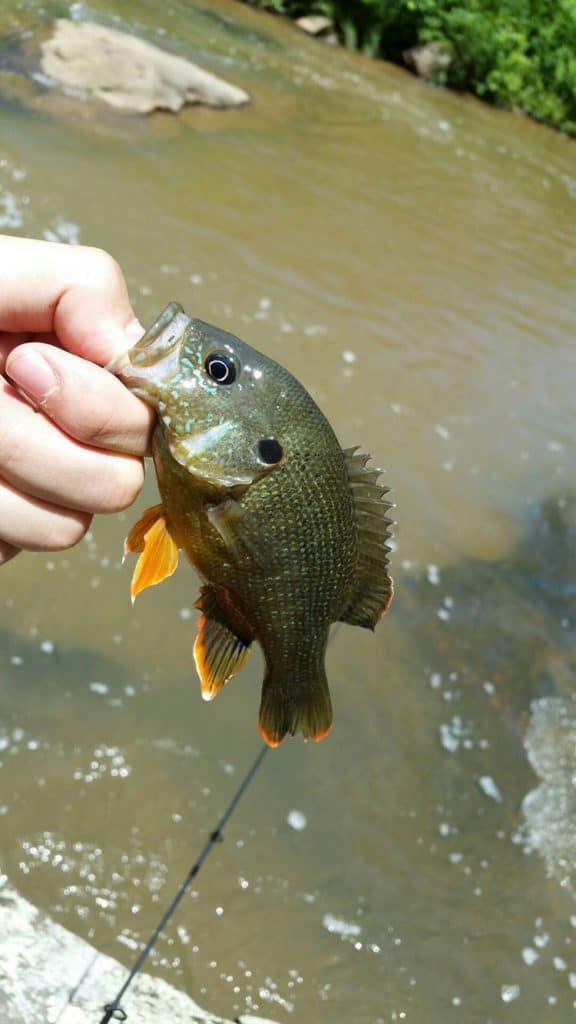Table of Contents
Sunfish have many different species, the most popular being the bluegill. They live in streams, lakes, and ponds. Some sunfish are better suited for ponds (and small lakes) than others. Please see our previous article on sunfish living in ponds. It explains which sunfish thrive in ponds, and which sunfish (and other fish) should not be put into a pond. Sunfish eat basically the same foods whether you have them in a pond or they are living in a lake.

Sunfish eat: Insects, mosquito larvae, crustaceans, and crickets are favored by the sunfish with smaller mouths; like the pumpkinseed sunfish and the bluegill. The members of the sunfish family with the larger mouths prefer frogs, crayfish, minnows, and snails.
Sunfish, also called bream, are considered panfish. As mentioned above they are found in clear water, streams, ponds, small and large lakes. They can range in size from just a couple of inches up to a foot in length. Despite some of them having a smaller mouth, they do have a full set of sharp teeth.
Like a lot of fish, the sunfish will slow down considerably, in the winter months. But, they will eat when the food is available and presented enticingly. Their diets may change with the seasons and it may stay the same. Part of that will be determined by their environment. As the temperatures begin to rise they will feed more heavily. By May, the bluegills are spawning, which they do frequently.
As with many other species of fish, they eat the most in the early morning and later in the afternoon/early evening. They are not very active during the heat of the day. The spring rain or an early winter snow fall will provide an outstanding food source. It washes insects and other food into the water. In the summertime the thunder will fluch insects from trees and other vegetation.
Forage, other young fish, and minnows are the main source of food for sunfish in farm ponds and small lakes. The sunfish that are along the edges of farm ponds or creeks will feast on crickets and grasshoppers, especially in grassy areas. Many crayfish are too large for sunfish, with smaller mouths, to eat. Their young are the perfect size for the sunfish with the smaller mouths. Sunfish will also feed on molting crayfish.
It is not recommended that you do it very often, but if you have a pond with bluegill you can feed them human food scraps; such as small balls of bread, corn, and crackers. But remember, they prefer worms, insects, and zooplankton. Also keep in mind that some sunfish are also used as bait to catch the much bigger fish; such as walleye, catfish, and trout.
With the many species of sunfish, did you know that the largemouth bass and crappie are part of the sunfish species? Along with green sunish, small mouth bass, rock bass, and black bass. I didn’t know that either. As far as how many species o sunish, it depends on your location. In North America living in freshwater are 28 species.
How do you know if you have a sunfish
There are 7 ways to determine whether you have caught a sunfish or something else. Most adults learned to catch sunfish as children, especially bluegill. But, sunish are often identified incorrectly.
Here are 7 external parts of the anatomy that will help you determine and confirm that you have a sunfish.
- Mouth size compared to body size
- Upper jaw length compared to eye
- Opercular flap length
- Opercular flap color and margin colors
- Opercular flap flexibility
- Pectoral fin length
- Body coloration
You can get a more detailed list online, that gives you specifics for 9 species of sunfish, particularly the colors to look for.
If that all sounds like too much to try to figure out on your own, you can get the sunfish for your pond (or small lake) from a fish hatchery. But make sure you have researched and have decided on what type of sunfish you want to keep in your pond. Because with certain spawning habits you may need to add a largemouth bass or other predatory fish.
This will keep the number of malnourished pond fish down.
Here are the top 6 most popular and largely found sunfish:
- Green sunfish – 2 to 8 inches long and up to 2 pounds. They like warm still water such as backwaters of sluggish streams, small shallow lakes, and ponds. Favorite food: dragonfly, midges, beetles, and freshwater shrimp.
- Longear sunfish – up to 9 ½ inches long and 1 pound. You can find this species in rocky and sand pools of creeks, rivers, lakes, bays, and ponds. These sufish primarily eat aquatic insects, crayfish, worms, and fish eggs.
- Mud sunfish – not actually a member of the sunfish family, but uses their name. They are a maximum 6 ½ inches long. The mud sunfish prefer sluggish weedy water that is 50 to 72 degrees. There is a recorded mud sunfish that was 8.3 inches long.
- Pumpkinseed sunfish – these are normally 4-6 inches in length but can reach up to 12 inches, and weigh up to 1 pound. They prefer vegetated and quiet small rivers, ponds, and pools of creeks. Their diet consists of crustaceans, ants, small salamanders, small fish, and water beetles.
- Redbreast sunfish – most abundant in the Atlantic Coastal Plain streams. These are 6-8 inches average length, but 10-12 inches is possible . They can weigh close to 2 pounds. These sunfish prefer deeper stream sections and vegetated lake margins. They eat aquatic insects, snails, crayfish, and small fish.
- Redear sunfish – these have white flakey meat and they fry up very nicely. The average size of a redear is 9 ½ inches and ½ a pound. But they can reach a whopping 4 ½ pounds. They love lakes, swamps, vegetated pools of small to medium rivers, and ponds. Their food choices are aquatic snails, amphipods, dragonflies, clams, fish eggs, and crayfish.
There you have the 6 most popular sunfish (besides the bluegill) and their information to help you determine if any of them are what you are interested in stocking your pond or small lake with. Depending on the species, you have quite a few options on what you are going to be able to feed them.
Best Areas for Ponds/Small Lakes
If you are going to have a pond (or a small lake) the optimum temperature in the fall is going to be 68 to 74 degrees. The pond water will lose the ability to contain dissolved oxygen if the temperature reaches 85 degrees or above. The higher temperatures will also cause your fish to be more active which in turn uses up more oxygen. Be extremely careful if you live somewhere that gets extremely cold in the winter, as the pond can freeze and kill your pond fish.
You also need to know that many times plants will grow all the way across a shallow pond, which a lot of pond fish will enjoy. There, of course, will be little wave action and the bottom of ponds are usually covered with mud. During the colder months, the fish will usually hibernate down in the mud, coming up to feed occasionally.
If you are looking for something besides a few sunfish, and a predatory fish to have in your pond you can check into Koi fish. Most of the sunfish can be in the pond with the Koi fish with no issues at all. This will give your friends, and family a variety of fish to admire when they come over to check out your pond.
When you decide to build your pond, there is one essential factor that we have not discussed, in any of our articles. Ponds can be freshwater, saltwater, or brackish. The type of water is going to determine what types of fish you can have in your pond. Most sun fish are freshwater fish, so if you choose to have a saltwater pond, you are going to have to do some extra research on the types of fish for that particular water choice.
Final Thoughts
Whether you choose freshwater, or saltwater make sure to do the research and talk to the local hatchery to determine which sunfish is going to be the best fit for you and for your pond. But no matter what type of sunfish you choose, we have given you plenty of options as far as what their diets could consist of.
If you decide to construct a pond on your land, or you already have a pond with some sunfish, Koi fish, or other fish please send us a picture. We would love to see what you have done and how you have it set up.
Until next time, we hope you are keeping safe in this crazy world of chaos, and as always, since fishing season is upon us (time to get that gear and that boat ready to go) Happy Fishing.
Here are some Human Foods that fish eat.
P.S. I’d Love Your Support On YouTube



